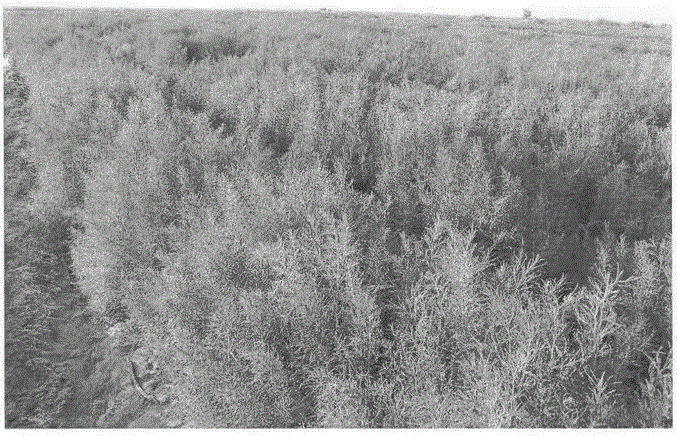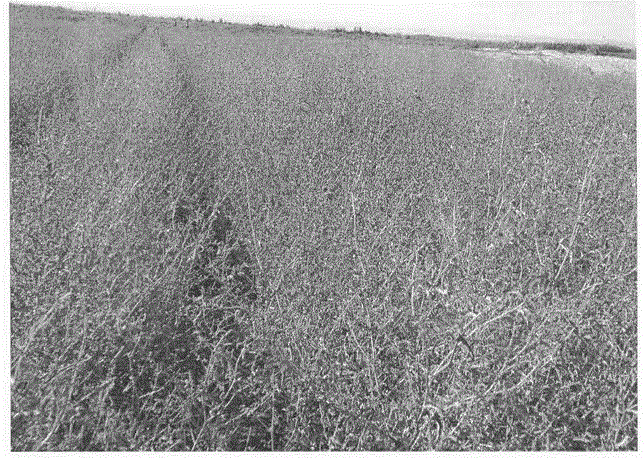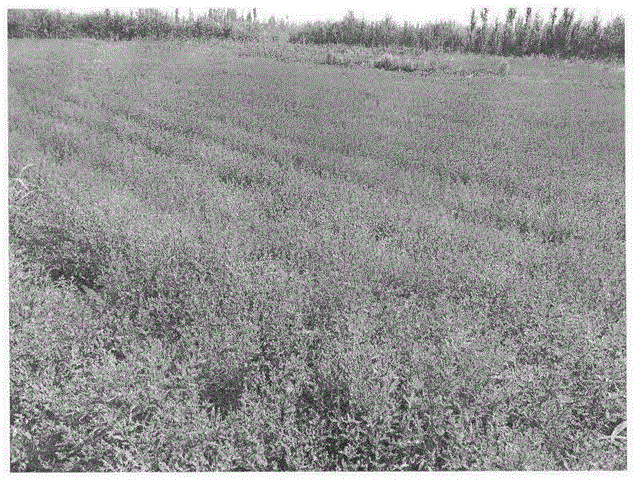Preparation method for halophyte silage
A halophyte and silage technology, which is applied in the field of halophyte-silage corn mixed silage and halophyte planting, can solve problems such as hindering agricultural development and restricting the improvement of agricultural productivity, so as to solve subsequent utilization problems and realize The effect of efficient use
- Summary
- Abstract
- Description
- Claims
- Application Information
AI Technical Summary
Problems solved by technology
Method used
Image
Examples
Embodiment 1
[0019] Example 1 (2014, Xiaoguai Township, Karamay)
[0020] Selection of saline-alkali land and halophytes:
[0021] a. Select the deserted saline-alkali land with a salt content of 1.0% in the 0-30cm soil layer, and plant the halophyte as red leaf quinoa;
[0022] sowing:
[0023] b. Sow in the first ten days of June. Ditch the flat land to be sown with a distance of 0.8m. The depth of the ditch is 0.2m and the width of the ditch is 0.3m. A drip irrigation belt is set in the middle of the ditch. On both sides, drip water immediately after sowing, and drip water once every 2 days during the emergence period. The amount of water dripping each time is 5cm across the edge of the ditch with a wet front. After the emergence of seedlings, judge the drip water according to plant growth and soil moisture conditions;
[0024] Silage production:
[0025] c, the first ten days of September, when the halophyte is the early flowering stage of red leaf quinoa, harvest the aboveground pa...
Embodiment 2
[0026] Example 2 (2014, Xiaoguai Township, Karamay)
[0027] Selection of saline-alkali land and halophytes:
[0028] a. Select the deserted saline-alkali land with a salt content of 2.0% in the 0-30cm soil layer, and plant the halophyte as spinach;
[0029] sowing:
[0030] b. Sowing in the first ten days of June, open ditches with a distance of 1.0m in the flat plot to be sown, the ditch depth is 0.2m, and the ditch width is 0.3m. A drip irrigation belt is set in the middle of the ditch. On both sides of the belt, drip water immediately after sowing, and drip water once every 2 days during the emergence period. The amount of water dripping each time is 5cm across the edge of the ditch with a wet front. After the emergence of seedlings, judge the drip water according to plant growth and soil moisture conditions;
[0031] Silage production:
[0032] c. In the first ten days of September, when the halophyte is the early flowering stage of the wild elm spinach, the above-grou...
Embodiment 3
[0033] Example 3 (in 2015, Xinjiang Oilfield Company's Karamay afforestation and emission reduction operation area)
[0034] Selection of saline-alkali land and halophytes:
[0035] a. Select an abandoned saline-alkali land with a salt content of 3.0% in the 0-30cm soil layer, and plant halophytes as Suaeda salsa;
[0036] sowing:
[0037] b. Sowing in the first ten days of June, open ditches with a distance of 1.2m in the flat plot to be sown. The ditch depth is 0.15m and the ditch width is 0.4m. A drip irrigation belt is set in the middle of the ditch, and the halophyte is sowed as Suaeda salsa seeds in the ditch. On both sides of the drip irrigation belt, drip water immediately after sowing, and drip water once every 2 days during the emergence period, and the wet front of each drip overflows 8cm over the edge of the ditch, and then judge the drip water according to the plant growth and soil moisture status after the emergence of seedlings;
[0038] Silage production:
...
PUM
 Login to View More
Login to View More Abstract
Description
Claims
Application Information
 Login to View More
Login to View More - R&D
- Intellectual Property
- Life Sciences
- Materials
- Tech Scout
- Unparalleled Data Quality
- Higher Quality Content
- 60% Fewer Hallucinations
Browse by: Latest US Patents, China's latest patents, Technical Efficacy Thesaurus, Application Domain, Technology Topic, Popular Technical Reports.
© 2025 PatSnap. All rights reserved.Legal|Privacy policy|Modern Slavery Act Transparency Statement|Sitemap|About US| Contact US: help@patsnap.com



